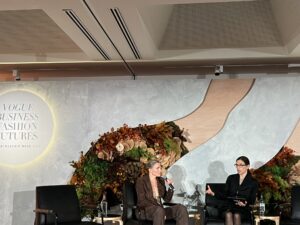Last week spotlighted fashion’s urgent reckoning with sustainability across three key events – the launch of COP28 in Dubai, Voices 2023 by the Business of Fashion in Oxfordshire, and Vogue Business’ exclusive Fashion Futures gathering at the Design Museum in London. Together, these high-profile convenings served as a clarion call for an industry plagued by pitfalls to step up and spearhead solutions. COP28 set the stage for fashion leaders to showcase progress and collectively finance pathways for net-zero and circularity.
The fast fashion industry has undoubtedly transformed how we produce, buy and dispose of clothing. With new fashion drops happening weekly and prices that seem too good to pass up, it’s easy to get caught up in the frenzy of constant consumption.
But there is a heavy price to pay for fast and cheap fashion. As highlighted at recent industry events like the United Nations Climate Change Conference (COP28), Voices 2023 by the Business of Fashion, and the Fashion Future Member event by Vogue Business, fast fashion is having dire social and environmental impacts, especially in developing countries.

Vast amounts of used clothing from Global North are being exported to countries like Ghana and Peru. Local second-hand clothing imports in Ghana reached $168 million in 2022. And over 15,000 tons of used clothing arrives in Peru’s capital Lima every year. Rather than supporting local economies, the onslaught of imported garments is threatening domestic manufacturing and retail industries in these countries.
These clothes also end up as waste at unprecedented rates. Second-hand garments that go unsold pile up in landfills and create pollution. In Ghana, a whole neighborhood has emerged around one landfill called Kantamanto, where people try to make a living sorting through the discarded clothing.
As the UN and industry groups like the Global Fashion Agenda have emphasized, urgent action and accountability are needed to mitigate the damage being done by fast fashion’s reckless overproduction and overconsumption. Brands must accelerate their sustainability efforts, governments need to implement appropriate policies, and collectively, we as consumers need to change our buying habits.
At the recent Vogue Business Fashion Futures event in London, over 300 industry leaders and innovators gathered to envision practical paths toward a circular fashion system. Speakers like designers Gabriela Hearst and Mara Hoffman discussed the uncomfortable tension between the climate crisis and fashion’s resistance to change.

The event also featured a start-up gallery with nine companies offering solutions for circularity, such as rental platforms, recycling technologies, farm-to-garment production, and blockchain-enabled digital garment passports. As Hoffman emphasized, fashion cannot achieve sustainability without first transforming its business model to be regenerative by design. The innovations on display prove alternatives are possible, but now bold action and investment must follow to scale these circular systems.
The path forward lies in investing in circular systems to keep clothing in use longer, choosing quality over quantity when we shop, and showing regard for the people and communities impacted along the fashion supply chain. We at Bodi.Me help the industry with sustainable Fashion Fit technology that help to extend clothes life, by picking the perfect fit in the first place of helping to choose the size for your favourite vintage piece. We all have a role to play in cleaning up fashion’s ugly side if we hope to break the devastating cycles of exploitation and waste.
The path forward requires collective action – from investing in circular systems to keep clothing in use longer, to consumers choosing quality over quantity, to showing regard for people impacted across supply chains. Our role at Bodi.Me is to support this shift through our AI-powered Fashion Fit technology, which matches shoppers with their optimal size and creates custom patterns to extend garment life, whether making new purchases or sourcing vintage. Perfect fit means clothes get worn and loved instead of discarded early due to poor size selection. Each of us, companies and individuals, must take part in transforming consumption and stewarding resources if we hope to rewrite fashion’s legacy from waste and exploitation toward equity, ecology and craftsmanship.
As we work to mitigate fashion’s social and environmental damage, events like Vogue Business Fashion Futures offer hope by convening and inspiring those poised to drive progress. But the message remains clear – we have no time to waste in revolutionizing supply chains, business models, and consumer behaviour for the better.

